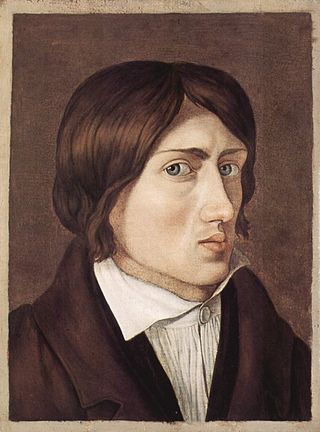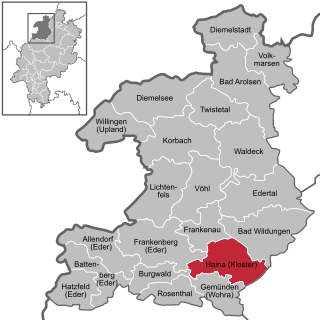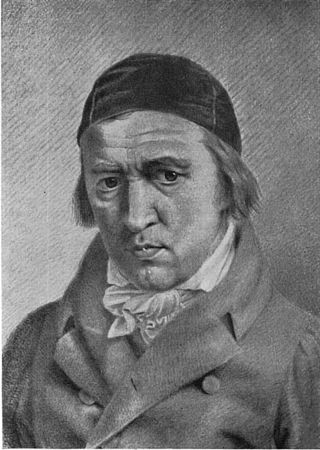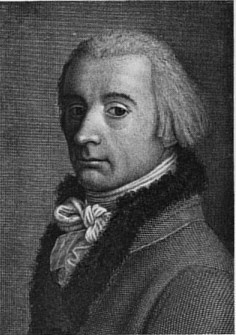Events from the year 1787 in art.

Franz Pforr was a painter of the German Nazarene movement.

The Roman Campagna is a low-lying area surrounding Rome in the Lazio region of central Italy, with an area of approximately 2,100 square kilometres (810 sq mi).

Italian Journey is Johann Wolfgang von Goethe's report on his travels to Italy from 1786 to 1788 that was published in 1816 & 1817. The book is based on Goethe's diaries and is smoothed in style, lacks the spontaneity of his diary report and is augmented with the addition of afterthoughts and reminiscences.

Johann Heinrich Wilhelm Tischbein, known as the Goethe Tischbein, was a German painter from the Tischbein family of artists.

Haina (Kloster) is a municipality in Waldeck-Frankenberg in northwest Hesse, Germany.

Ferdinand Jagemann was a German painter; known primarily for his portraits.

Georg Melchior Kraus was a German painter. He was a co-founder of the Weimar Princely Free Drawing School, together with Friedrich Justin Bertuch, in 1776.

Johann Heinrich Meyer was a Swiss painter, engraver and art critic. He served as the second Director of the Weimar Princely Free Drawing School. A close associate of Johann Wolfgang von Goethe, he was often referred to as "Goethemeyer".

Friedrich Georg Weitsch was a German painter and etcher.

Friedrich (Fritz) Bury was a German artist born in Hanau. He studied first under his father Jean Jacques Bury, who was a goldsmith and professor in the Academy of Design in Hanau, and then with Johann Heinrich Wilhelm Tischbein. In 1780 he visited Düsseldorf, and two years later went to Rome; thence to Dresden, and finally settled in Berlin, where he was patronized by the Queen of Prussia. He painted historical pictures and portraits. A 'Cupid triumphant' by him is in the Hague Gallery.
The Tischbein family was a German family of artists, originating in Hesse and spanning three generations. The family patriarch, Johann Heinrich Tischbein (1682–1764), was a master baker at the State Hospital in Haina. The Tischbeins also produced a number of master carpenters..

Christoph Heinrich Kniep (1755–1825), was a German painter. He is renowned for accompanying Goethe in his Italian Journey to Naples, Paestum and Sicily, executing several drawings whilst there.

Young Man at His Window is a painting of 1876 by the French Impressionist Gustave Caillebotte (1848–1894). The oil on canvas painting measures 117 by 82 centimetres. It is in the collection of the J. Paul Getty Museum in Los Angeles.

The Casa di Goethe is a museum in Rome, in Via del Corso 18, dedicated to Johann Wolfgang von Goethe, his Italian Journey and his life at Rome in the years from 1786 through 1788. During his journey Goethe wrote a journal and also many letters which would be published in 1816-17 as the Italian Journey.

Goethe in the Roman Campagna is a painting by Johann Heinrich Wilhelm Tischbein, a German Neoclassical painter, depicting Johann Wolfgang von Goethe when the writer was travelling in Italy. Goethe's book on his travels to Italy from 1786–88, called Italian Journey, was published in 1816–17; the book is based on his diaries. Since 1887, the painting has been in the possession of the Städel Museum in Goethe's hometown Frankfurt.

August Albrecht Christian Tischbein was a German painter and lithographer from the Tischbein family of artists.

Johann Heinrich Lips was a Swiss copper engraver; mostly of portraits.

The Temple of Juno in Agrigento is an 1828-1830 oil on canvas painting of by Caspar David Friedrich. It is now in the Museum für Kunst und Kulturgeschichte in Dortmund, which bought it from a Cologne art dealer in 1951. It is said to have been previously owned by the F. A. Brockhaus publishers in Leipzig.
Friedrich Ludwig Heinrich Waagen also Christian Friedrich Ludwig Heinrich Waagen, Wagen or Wage) was a German portrait, history and landscape painter. Hardly anything is known about his works. However, he had acquired extensive knowledge of art, amassed a collection of paintings in Hamburg and was known to friends with or in-laws of many important personalities of his time. Gustav Friedrich Waagen (1794-1868) and Carl Waagen (1800-1873) are his sons.
















